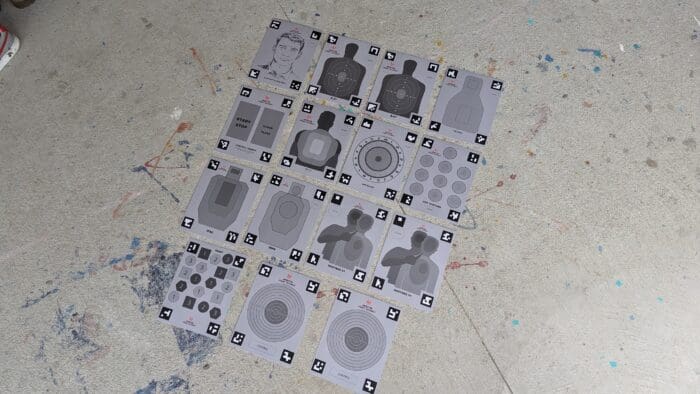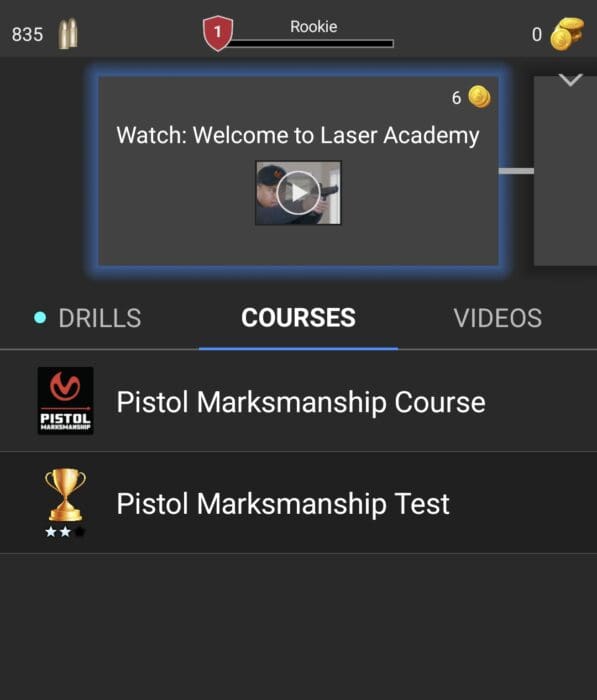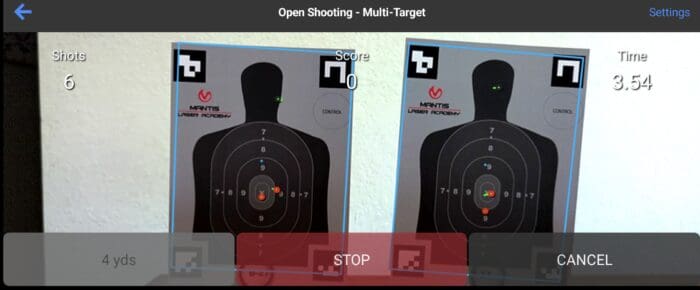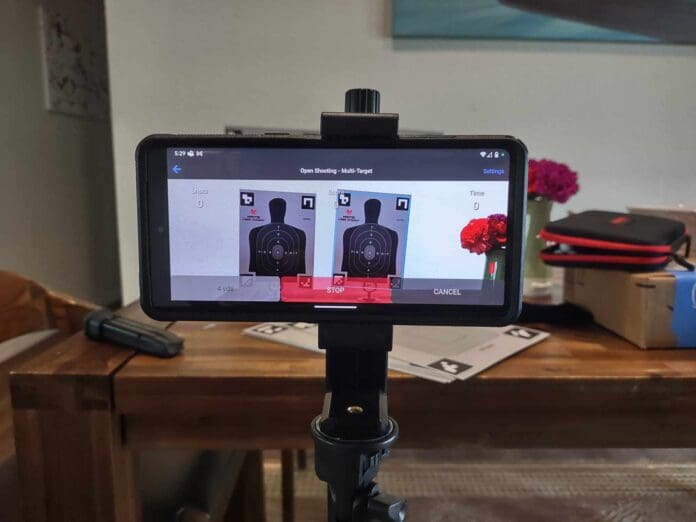The ratio of keeping your skills sharp to the amount of money you have to spend on ammo is one that’s spiraling out of control. I miss the days of 9mm running for 8.99 a box. Sadly, I don’t think those prices will ever come back. Lots of dry fire is the new normal, but dry fire can be a rather dull affair. The good news is that technology has stepped in to make dry fire a bit more entertaining. As such, the latest and potentially greatest entry into the high-tech dry fire market is the Mantis Laser Academy.
There is a lot to the Mantis Laser Academy, so let’s break it down step by step. Mantis are the dry-fire people. They produced the first sensor that provided real-time feedback on your trigger pulls. They’ve evolved, creating better sensors, the Blackbeard system for ARs and the MCX, and now the Laser Academy. The Laser Academy has four main parts to the system.
We have the:
- App
- The laser
- The targets
- The support gear
Breaking Down the Laser Academy One by One
To provide the most information possible, I think it’s easier to break down each component. Let’s start with the app.
The App
The Laser Academy App is available for iOS and Android phones. It’s a fairly small download, and it’s designed to utilize your device’s camera to ‘see’ and recognize targets and the ‘shots’ fire on them. The Laser Academy App comes with several different modes under three main categories. We have Drills, Courses and Videos.

Drills are the main training portion. Here, we have a variety of drills, including drawing, reloading, close contact form holster, free fire and more. The drills also have a multiplayer competitive option, so you and your friend can train and drive up the stakes via competition.
Under courses, we currently only have one course, and it’s the Pistol Marksmanship Course and the Pistol Marksmanship Test. We’ll talk a bit more about that later. We also have videos that break down a variety of topics and serve as training guidelines. There’s a lot of good info here.
The Laser
The laser, which Mantis calls the Pink Rhino for reasons unknown to me, is a core part of the system. The laser is available in a number of different calibers for rifles and handguns. I have the 9mm variant, and the device drops in and is fired when the firing pin strikes the ‘primer’ of the laser. The app can record where the laser hits and allows you to track accuracy and progress. In the event your laser isn’t hitting where your sights sit, you can calibrate the laser offset quickly and easily.
The Targets
The system comes with 15 targets. Two of the targets repeat themselves, and one is a calibration target. There are 12 different practical target designs. They include a variety of options, including IPSC and IDPA targets, the B-8, BT-55 and even a Dot Torture target. I got both large and small targets with my setup.

Each of these targets has four unique signs in the corner, and the app reads those little signs to recognize the target. This allows the app to give you a proper score depending on the target.
The Support Gear
The support gear includes a tripod and phone holder, a case to carry the stuff and various target stands. The inclusion of these little items means the system is ready to run right out of the box.

Sighting In With the Laser Academy
I started with some simple free-style dry fire to get the hang of the system, but quickly moved on to try the Pistol Marksmanship Course. The course is shot at either four yards with the big targets or two yards with the smaller targets. We used the IDPA, IPSC, Bull’s Eye, Dot Torture, the BT-5s and Hunt Target.
The course consists of 13 stages, each becoming increasingly difficult. Each stage has a minimum passing score and round count, and you are assigned an overall rating. Once you have completed the course, you can take the test. The test is made up of five stages. This isn’t a review of the course, but it’s not difficult to pass, but it is difficult to perfect. A perfect score even gets you a free patch from Mantis.

Shooting the course gave me a good idea of how the system functions overall. Setting the system up and shooting is pretty easy. You do need a good, well-lit area, or the camera will have a hard time reading the targets. It doesn’t need to be super bright. An overhead light is good enough. Calibrating your gun and laser is important, so I’d always start by doing just that.

The app provides both audible and visual cues when you hit the target. If you go to the drills, at the end of every drill, you can see a picture of your target, with your hits marked and scored with a split time between shots. My favorites are the speed reload drill, the holster draw drill and the malfunction drill. They work exceptionally well with a standard handgun that requires you to rack the slide with every operation.
The Laser Academy and Skill Improvement
To establish if this thing can really help you build skills, I decided to work on my draw. I wanted to establish a sub-second draw from concealment with one accurate shot on target. One of the neat things you can do with most of these drills is adjust the amount of shots fired per session and adjust a timer. You, of course, get your time between shots, but you can get a failure buzzer if you go too slow.
I practiced daily for 15 minutes for a few weeks. The same draw and fire over and over and over. It took some time, but I was able to get my draw down to less than a second with a shot on target. An accurate shot at that. I went outside, touched the grass and tried the same. Live fire added a little more pressure, but after a few tries, I was getting the gun out and into action in just under a second.
It’s not a huge surprise that constant practice and training make a difference. Could I have accomplished it without the Laser Academy? Yeah, probably, but the Laser Academy kept me training and practicing because I got accurate time-to-first-shot times. I watched that time slowly drop over and over, and the fact I had a tiny target that recorded my shots forced me to be accountable for my accuracy while I practiced.

I’m going to apply that same effort to reloads, malfunction fixes and more. I want to see those times drop and my skills improve. The Laser Academy app, targets and laser make training fun and entertaining.
Final Thoughts On Laser Academy
The Laser Academy system delivers a fantastic and innovative training option. The system is responsive, easy to set up, and relatively drama-free. It’s a useful training app and I hope Mantis continues to release various courses and support the system. They have released numerous targets, including a Christmas theme Jingle Bells, the Konami Code and a Die Hard target. You can print these for free or order the extra targets online. The price of this system is $159, but the travel system is only $99.
Ratings (Out of Five Stars)
Ease of Use – *****
Setting the system up takes all of five minutes at most. You can shoot quite quickly, and there is nothing overly complicated or difficult in setting up the app or gun.
Bang For Your Buck – ****
$159 isn’t chump change, but with the price of ammo it’s not exactly that expensive either. It’s a one-time purchase, there is no subscription or monthly service fee. Buy it once, set it up and forget all about it. You get everything you need to start shooting and get after it.
Overall – ****(and a Half)
I’ve tried a lot of laser training systems. Of them all, the Laser Academy is my favorite. It’s the best blend of simplicity, affordability and useful training. It’s easy to use, easy to setup, and entertaining enough that you won’t get bored after five minutes of dry fire.
Find it at mantisx.com.





“The course is shot at either four yards with the big targets or two yards with the smaller targets.”
Um, are these numbers correct- 2 and 4 yard target practice seems kinda short/close, dunnit…?
It’s just light and shapes. By varying the size of the target and using the magic of trigonometry and ballistics any range can be simulated. Your phone has a pretty decent computer inside it to do all these calculations.
To be more specific- I do ALL of my live-fire training at 25 yards… so I’m having a bit of trouble visualizing how being four (or two) yards from the target I’m aiming at could possibly be a realistic training aid for real-world shooting scenarios.
This seems to be more like a video game/entertainment type system… that happens to allow tracking of the user’s “shooting” avidity to be shared with whomever’s interested via the World Wide Web.
What size targets are you shooting at 25 yards? Shooting a 3″ target at 4 yards would be like shooting a 19″ target at 25 yards. Shooting a 1″ target at 4 yards would be like shooting a 6″ target at 25 yards.
Not really. Your shooting errors are more pronounced as the distance increases.
You can hole in hole a pellet gunm at 3 feet but put a dime at 3 yards and its different.
You funny
3 feet equals 3 feet
3 yards equals 9 feet
The spread will be proportional to the distance assuming:
A reliably precise shooting platform.
A reliably precise projectile.
No drop or drift.
I shoot TQ-15 Vital Anatomy Qualification Targets (23″×35″) at 25yds offhand with both eyes open.
So, you’re suggesting that dry firing at a really small target 2-4 yards from me is comparable to actual live fire at a human torso-sized target 25 yards away?
Maybe it’s just my age (and experience) showing- but I’m finding it VERY difficult to envision how the two could be comparable… considering perspective, physics, and other such things.
Dry fire and live fire are different things. No one suggested that they are interchangeable. If you have endless resources for ammo, and a range that’s available to use 24/7, then stick with only live fire. People have been practicing sight alignment and trigger control with dry fire for decades. It isn’t a new concept.
I fully understand that it cannot replicate actual live fire, but I just cannot picture how pointing a firearm at a small target a few feet in front of me can reasonably be considered similar to pointing a firearm at a target that’s 75 feet away.
To me- it just don’t add up.. (in feet)
Peter, math rules !
It is a thing.
R E L A X and let it come to you. Be open.
I’m old, an instructor & RSO, and I’ve experienced exactly the paradigm shift this type of training takes you thru.
There is a drill that seemingly sounds really easy, but is deceptively not. Mount three of your targets about a foot away from each other, side by side by side. Then stand 5 feet in front of the center target. Shoot double taps at the sternums of each target, L-R-C while on the clock.
Peeps think they can’t miss because they’re so close; but you have to move your arms more than you would if you were 15-20 yds away, and most tend to either over or under swing their arms (especially when on the clock).
Try it for yourself.
Life is funny… What we think and believe doesn’t necessarily corroborate with reality.
So, you are saying that dry firing at a target 10 feet away will improve my live-fire hits on a target 75 feet away? Ok.
FWIW- I stopped live fire training at less than 25 yards about five years ago because I realized that in 40+ years of shooting, I have consistently hit center mass within a 3″×4″ box (max) from 5-7 yards, a 4″×6″ box from 7-15 yards, and a 12″×12″ box at 25 yards (9, .40, and .45 caliber pistols and revolvers, offhand, both eyes open).
But, I just might try your three target drill and see what happens…
(but I sure as hell ain’t gonna start using a “shooting” app… or any app for that matter other than the ONLY ones I’ve ever used- phone, text, and camera)
I am intrigued by the mantis blackbeard since it resets the trigger, the rest of their line is just meh.
Virtual reality training seems to be the ticket right now, as soon as someone releases a call of duty type experience with everything else is gonna be old news. Tracking won’t matter cause there will be so many people :
playing
It’s more exciting when you accidently use live emu. Like the time I shot my TV with the Weatherby.
Get the app,,,,,,,No thanx, my phone does a good enough job spying on me the way it is.
Now this is curious.
I was playing XBox car racing game and said to myself, I wonder what the real spec’s on this car are. I reached over typed into my phone the manufacturer of the car, let’s say Ford, and Google popped up with the exact year and model that I was using.
My only answer is that when that little circle is spinning , the loading circle, its relaying information to my phone.
This is one reason there will never be a Civil War 2.0 in the U.S., surveillance is to tight. ‘They’ know where you are, where you been, who you been with and what you did or are doing.
I pray for sunspots and meteor showers.
Some of these apps really do keep track of every practice dryfire shot you take -how fast, how accurate, how often you train and saves all of this session information on the company’s own servers after beaming it all home through the cloud. The system I use doesn’t even save anything on my own phone unless I take a screenshot and keep the targets in my saved photos. At least not that I know of. There might be seventeen other apps on my phone spying me instead
May I ask what system you are using?
I like the idea of this kind of training, but I like others do not want my phone tracking and sending all my info to some servver somewhere.
I’m using G-Sight laser training pro. They have a few different apps right now and one of them is very new. I’m afraid that this older app is going to be dropped for the newer version that is coming out that does record scores and tracks “progress.”
For the most part these apps are interchangeable between the laser cartridges available out there. Some of the cheaper laser cartridges don’t produce a bright enough dot or stay lit on the target long enough for the app to register the “hit” but I haven’t run into any incompatibility yet.
I went with the G-Sight laser for my Makarovs because it was the only company that made a true 9x18mm laser that didn’t need to be modified from a 9x19mm Luger or a 9x17mm (.380) and trimmed or shimmed. I’ve been impressed by how accurate the laser is and how repeatable the hits are.
Has anyone considered NOT using a gun related app on a device designed to snoop and track you?
Just asking…
SIRT pistol training using reactive laser targets.
My fav targets are the “cans” that fall over when lasered.
They have a very small target zone; kind of forces good marksmanship fundamentals & techniques.
I don’t need to know my times and tracking theoretical recoil movements, etc, only if I’m improving on my accuracy.
Slow is smooth, smooth is fast.
Can anyone talk about the differences between the Laser Academy and the Mantis X10 system?
The X10 system does not have laser. The X10 tracks the movement of your firearm (such as from draw to pulling trigger) and times how long each phase of your shooting is tracked. You can track how consistent your draw motion is for either dry fire or live fire. It tracks very accurately if you are pushing down on your firearm, flinching, or changing grip pressures (which translates into movement of the firearm leading to inaccuracy).
Dry Fire>Gadgets
Talking about the shooting gear, I have to mention my CVLIFE 1-8X24 rifle scope and my red dot magnifier. They really help me a lot when I hunt.
https://www.cvlife.com/products/cvlife-bearpower-1-8×24-rifle-scope-with-30mm-cantilever-mount
https://www.cvlife.com/products/cvlife-auto-brightness-adjustment-red-dot-sight-with-3x-magnifier-combo
When someone figures out a system where I don’t have to rack the slide every “shot” we can talk.
I recently bought the Laser Academy and thought I’d try some things that may address privacy concerns. When I got the kit, I created and account and signed in to it on the app. The results of my dry fire sessions was saved to their web site.
Today, I signed out of the app, which disables most of the drills in the app. However, the Single Target drill is still available, and realistically, is probably all I need. The app still worked to record shots, calibrate the point of aim, etc.
I use an iPad rather than a phone because the screen is easier on my aging eyes, but you can do the same in any phone: Turn off wi-fi. I don’t think bluetooth plays into it. At any rate, the training session was obviously not sent to the mother ship. I thought perhaps the session info would be sent after I enabled wi-fi and logged in again, but that didn’t happen. I can’t say for certain that the app didn’t sent home some info after reconnection that it didn’t tell me about.
If I was to do this again, I would buy just the Pink Rhino cartridge, download an print a couple targets, which are a free download, and install the app, which is also free.